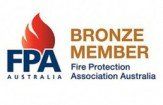QUALITY ELECTRICAL & FIRE SERVICES
FULLY LICENSED PROFESSIONALS WITH OVER 30 YEARS ELECTRICAL AND FIRE EXPERIENCE
FAQ
Got a question about the services on offer at DG Electrical & Fire? We've compiled some of the questions we're asked most often below. If you're looking for more information, don't hesitate to contact our friendly team.
ELectrical
-
How does an electrical safety switch save lives?
On a normal power circuit, the current flowing to an appliance returns through the neutral wire. If the circuit is compromised, the electricity can leak to earth through a person in contact with the appliance, causing death or serious injury.
A safety switch detects the loss of power from the circuit, and cuts the supply of electricity in as little as 30 milliseconds – 0.003 seconds. Importantly, this response time is faster than the critical section of a heartbeat, and therefore significantly reduces the risk of death or serious injury.
-
What is appliance test and tagging?
Testing and tagging an appliance requires completing a safety check to ensure an appliance is functioning correctly, minimizing risk of electrical shock. Test and tag inspections are completed on appliances that are regularly used such as kettles, toasters, and power tools. They are required to comply with Work Health and Safety Australian standards.
-
How often should electrical wiring be checked?
It is recommended that periodic inspection and testing is carried out at the following times:
- for tenanted properties, every 5 years or at each change of occupancy, whichever is sooner.
- at least every 10 years for an owner-occupied home.
- at least every 5 years for a business.
-
What is an RCD and how does it work?
An RCD is a safety device that monitors electrical current flowing within a circuit from the switchboard. It works on the principle that the electricity current flowing in must be equal to the current flowing out of the circuit. If the RCD detects an imbalance in the electrical current, indicating a leakage to earth, e. g. current flows through someone’s body to earth, the RCD immediately cuts the electricity supply to prevent electrocution. RCDs are extremely sensitive, disconnecting within 10 to 50 milliseconds of detecting 30 milliamps or more of leakage current.
-
What are some of the compulsory tests that are necessary in order to verify that the electrical work complies with all standards?
There are various tests to be carried out along with a visual inspection for a standard voltage electrical installation. Some of the tests include:
(a) Checking for Continuousness of the earthing system.
(b) Insulation resistance
(c) Polarity
(d) Correct circuit links
(e) Verification of impedance required for automatic
Disconnection of supply (earth fault-loop impedance)
(f) Operation of RCDs AS/NZS 3017 “Electrical Installations
-
Is an RCD the same as a circuit breaker?
No. Many homes already have circuit breakers installed. However, circuit breakers only protect against overloading and short circuits. They do not prevent electrocution
-
How do I tell the difference between an RCD and a circuit breaker?
An RCD looks like a circuit breaker but also has a test button. Combined RCD/circuit breaker are available also. These devices provide protection from overload, short circuit and electrocution. They also have a test button.
-
Why does my house not have RCDs?
Since 2000, it has been compulsory for all new homes to have two RCDs fitted to protect the power point and lighting final sub-circuits as part of the initial electrical installation. However, homes built before 2000 were not required to have two RCDs fitted. Also from 1992 to 1999 only one RCD was fitted to protect some of the power points and not the lighting circuits.
-
Where are the RCDs fitted?
RCDs are required to be fitted at the origin of the power point and lighting final sub-circuits which will be at the main switchboard or distribution board for the residence
-
If RCDs are fitted, how can I check if they are operating correctly?
All RCDs are manufactured with a test button. Homeowners and tenants should press the test button every three months. Pushing the test button simulates an earth leakage fault and indicates whether or not the device is operating correctly. Electrical clocks and timing devices may have to be reset after the test button has been pushed and the RCD turned back on.
-
RCDs must be installed to meet the AS/NZS 3000:2018, Wiring Rules – what does this mean?
AS/NZS 3000:2018, Wiring Rules is the minimum safety standard that all electrical installing work must meet in Australia and New Zealand. All licensed electrical contractors will have a copy of this standard and are familiar with its requirements.
-
Will you do the electrical wiring for our renovation?
Yes. Though we specialise in commercial and real estate work, we also provide homeowners and renovators with affordable electrical work. From switching lights to rewiring and house renovations.
-
Our issues with our switchboard out of trading hours. Can you help?
Of course. DG Electrical & Fire is on-call 24/7 for all emergencies. We're more than happy to get you back up and running any time of day or night.
-
Why is my smoke alarm beeping chirping?
As annoying as a beeping/chirping alarm is, it should not be ignored. The smoke alarm is equipped with a sounder and LED’s in order to communicate with you. The sounder is used when the communication is important (or imminently dangerous).
The two main reasons that smoke alarms chirp or beep is to alert the occupants of a low power condition or to alert of a contaminated detection chamber. To distinguish between the two, please take the following steps;
Power condition – For a mains primary powered smoke alarm look at the smoke alarm and ensure that the green LED is illuminated. You may see the red LED flash every 40 seconds, this is perfectly normal and indicates that a “self-test” cycle has been conducted. If the green LED is not illuminated, then there has been a mains power failure and the smoke alarm back-up battery is nearing depletion, please check and reset the circuit breaker in your home’s distribution board and return to examine the status of the indicators.
If you have a mains primary powered smoke alarm with a replaceable 9-volt Alkaline battery and the alarm beeping/chirping coincides with the red LED indicator flashing (once every 40 seconds), then this is an indication that the back-up battery is in need of replacement. Please replace the depleted battery with one of the following brand types;
Duracell MN1604,
Energizer 6LR61,
Philips 6LR61,
Varta 6LR61 or
Ultralife U9VL-J Lithium
If you have a mains primary powered smoke alarm with a 10-year Lithium, rechargeable, non-replaceable battery back-up that has been chirping/beeping as a result of mains power failure and the battery is nearing charge depletion, the alarm may continue to chirp/beep for a few hours while the rechargeable battery is being recharged after mains power restoration. This will stop as soon as the battery charge point exceeds the lower threshold.
On any occasion where the alarm head is removed from its base-plate, this would be a convenient time to also run a vacuum cleaner with a nozzle around the air inlet grills. This will remove any loose dust debris that could be the cause of false alarms or beeping/chirping in the future.
If the chirping/beeping is not being indicated as a loss of mains power or a depleted back-up battery, then it is likely that the smoke alarm may be contaminated with dust. Remove the alarm head from the base and use a vacuum cleaner with a nozzle fitted or a compressed air source to dislodge any loose dust from the chamber. Re-install to determine if the chirping or beeping has stopped.
Fire
-
How often do I have to have my fire extinguishers inspected?
All Fire Extinguishers in commercial premises (warehouses, offices, retail stores, factories etc.) and public buildings (hospitals, schools, movie theatres etc.) as well as multi-occupancy residential buildings must be inspected every 6 months in accordance with Australian Standard 1851. This includes Fire Extinguishers, Fire Hose Reels, and Fire Blankets etc.
-
How many Fire Extinguishers do I need?
The first step is to do a risk assessment to work out what type of fires may potentially occur in your workplace. Placement of Fire Extinguishers is governed by Australian Standard 2444 and the Building Code of Australia. As a guide the requirement is one extinguisher every 15 metres if practicable for Class A fires and every 20 metres for Class E and F fires. Obviously a common sense approach is advised in Fire Extinguisher quantities and locations due to the vast number of building configurations possible. This information should be considered as a general guide, not as an exact rule.
-
Does the class of the building require it to have emergency and exit lighting?
Every class 5,6,7,8 or 9 building where the storey has a floor area more than 300m2 needs to have emergency and exit lighting.
-
Do I need to have my fire systems regularly checked?
Absolutely. Aspects of your fire protection/detection systems should all be regularly checked. Contact our team to discuss the best schedule for your property.
ANNUAL FIRE SAFETY STATEMENTS
-
What is an Annual Fire Safety Statement (AFSS)?
The annual fire safety statement is a document issued each year by the building owner or their agent. ... It also certifies that each of the measures is capable of performing to an appropriate standard (specified in the fire safety schedule for the building).
-
What is a fire safety schedule (FSC)?
The fire safety schedule is a schedule of fire safety measures installed in the building and their standard of performance.






































